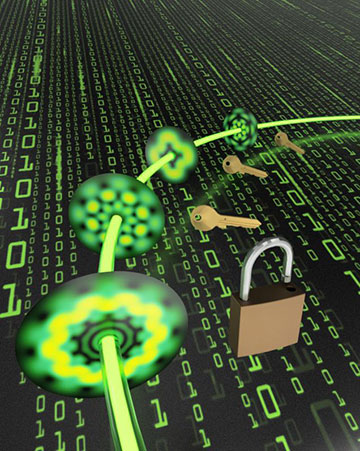
Researchers at the University of Witwatersrand in South Africa have used photons encoded via their orbital angular momentum to demonstrate “quantum secret sharing” in 11 dimensions for 10 participants. [Image: Wits University]
Quantum key distribution exploits the strange laws of quantum mechanics to generate a secret key that can in principle be shared to send and receive messages with complete security. However, it is a peer-to-peer technique that only allows communication between two parties. As such, it is not suited to building networks that enable communication within groups—allowing, for example, emails with multiple recipients.
Now, physicists in South Africa have demonstrated a practical way of distributing secret keys between three or more people using what is known as structured light. Their scheme sets a record for the highest number of participants and dimensions for what is known as “quantum secret sharing” (QSS) (Laser Photonics Rev., doi: 10.1002/lpor.202000012).
Swapping secrets
The idea of QSS is to divide and share secret keys among multiple parties and then have the people involved collaborate to securely reconstruct those keys. First proposed in 1999 by André Berthiaume and colleagues, it was initially envisaged as using entangled photons. However, the difficulty involved in entangling multiple photons made this scheme hard to implement and limited the number of people that could share the keys.
An alternative approach involving single photons was put forward and demonstrated in the early 2000s. The idea here is instead to have a multi-stage process in which all people sharing the key perform a series of operations on a single particle. But with just two dimensions, this scheme was found to be unsecure since it allows dishonest parties to glean some information about which bases other people are using. This prompted researchers to try and develop single-photon methods with higher dimensions.
In this case, the photon is in a superposition of many states, with each state representing one dimension. Traditionally, quantum protocols exploit polarization as their degree of freedom but because there are just two possible states—horizontal and vertical—they are limited to two dimensions. But so-called structured or patterned light can give access to multiple dimensions.
Encoding OAM
The latest work, carried out by OSA Fellow Andrew Forbes and colleagues at the University of Witwatersrand in Johannesburg, exploits the patterns offered by orbital angular momentum (OAM). The protocol involves one of the communicating parties known as the distributor preparing a single photon from a set of mutually unbiased bases and then modulating that state using unitary operators x and y.
The distributor then sends the photon to another participant, who carries out their own unitary operations on the particle using operators x and y that they chose at random. That person then forwards the photon to the next participant, who does the same thing, until the last of the communicating parties sends the photon back to the distributor.
By asking each of the other participants to reveal their choice of y, while keeping the x values secret, the distributor can set the value of the first bit in the secret key by making a suitable measurement on the photon. The other parties can then obtain the same bit value after revealing to each other their choices of x.
Creating the full key involves repeating this process a number of times to build up a string of multiple bits. As with quantum key distribution, any cheating on the part of the participants or eavesdropping from an outsider can then be revealed by publicly comparing a subset of the bits. If the communicating parties agree on the values of all of the bits then they use the remaining ones as the secret key, which they can subsequently use to encrypt and decrypt messages securely. Otherwise, they know that foul play has occurred and they have to start the process again.
Perfect vortex beams
Forbes and colleagues employed what are known as perfect vortex beams, whose width is independent of the OAM that they carry. If a beam has OAM its wavefront spirals around its propagation direction, and varying the twist of the spiral in principle gives access to an infinite number of dimensions. Having a perfect vortex means that the OAM modes can be manipulated independently of one another, coherently and all at the same time.
In this way, the researchers were able to demonstrate QSS in 11 dimensions for 10 participants. This betters their own work from a few months earlier that introduced vectorial structured light, combining OAM and polarization. While this was the first demonstration of vector beams for QSS, the complexity of the scheme limited the protocol to three dimensions with three participants.
The researchers point out that they did not actually use single photons in their work, but instead relied on laser light attenuated down to the single-photon level. They say that this could leave the scheme vulnerable to hackers who siphon off some of the photons, but argue that such attacks could be mitigated by employing decoy states or even by switching to single-photon emitters.
What's more, they note that perfect vortex beams have been sent through free space at up to hundreds of meters—adding that much longer distances might be possible in the future. As such, they say, “real-world deployment of our approach is feasible with appropriate engineering.”
Their next steps are to test the protocol on a free-space link at the University of Witwatersrand, and then attempt a composite free-space to fiber link.
